Put a Stop to Fidgety Behavior During Grooming Sessions
All good horsemanship starts with a healthy horse, and one of the best ways to ensure that your horse is in good health is to groom him regularly. Grooming promotes a healthy coat, and if you get into the habit of doing it every day, it’ll prevent you from missing any type of injury on your horse because you’ll be going over every inch of his body. Not only do grooming sessions physically benefit your horse, but they’re a great chance to bond and build a stronger partnership. While grooming is simple in practice, it can turn into a real chore, and even become dangerous, if your horse is anything but cooperative. Behavior like fidgety feet, pawing, rearing and running backwards, can quickly make grooming impossible. Nearly all grooming problems can be solved by doing the Fundamentals groundwork exercises with your horse. The exercises allow you to earn the horse’s respect while building his trust in you as a leader. Since all horse problems stem from either a lack of respect or fear, or in some cases both, the groundwork will nip the unwanted behavior in the bud. If you’ve taught your horse the Fundamentals and he’s still giving you trouble, follow my tips below.
Set Your Horse Up For Success
If you know your horse has a problem standing still while you groom him, correct his behavior by working with him in an open area like an arena or roundpen where he has room to move his feet. If you tie him up or put him in a small, enclosed space like a grooming bay and try to force him to stand still, you’ll not only have a fight on your hands, but the situation can turn dangerous quickly. When a prey animal like the horse feels trapped and his ability to run is taken away from him, he’ll become defensive and fight. So the best place to practice teaching your horse to stand still while you groom him is in an open area where he can move his feet.
With that being said, it’s important to rule out the possibility that your horse doesn’t have a grooming problem, but rather a tying problem. Horses that haven’t been taught to stand calmly while tied can get very reactive when you tie them to something solid because they feel trapped. If you suspect your horse’s real issue is tying, there are a number of resources you can use to train him to tie including television show #200 that you can watch on the No Worries Club website and the “No Worries Tying” DVD that comes with the purchase of an Aussie Tie Ring. I recommend always using the Aussie Tie Rings to tie all horses up. I’ve seen some really horrible accidents, and even deaths, occur when horses are tied up to something solid that doesn’t allow them to move their feet.
One of the biggest mistakes I see people make is taking a horse that’s been locked in a stall for hours on end and immediately putting him on cross ties and wondering why he won’t stand still. It’d be like taking a kid who has been in a classroom for eight hours straight out to the playground and getting upset that he wants to run around and not sit quietly on a bench. It’s unrealistic and unfair.
So if your horse has been stalled and is full of beans, do some groundwork with him before grooming him so that he’s in the right frame of mind to stand still and relax while you brush him. If he’s using the reactive side of his brain and wants to run and play, he’ll want no part of using the thinking side of his brain and standing still.
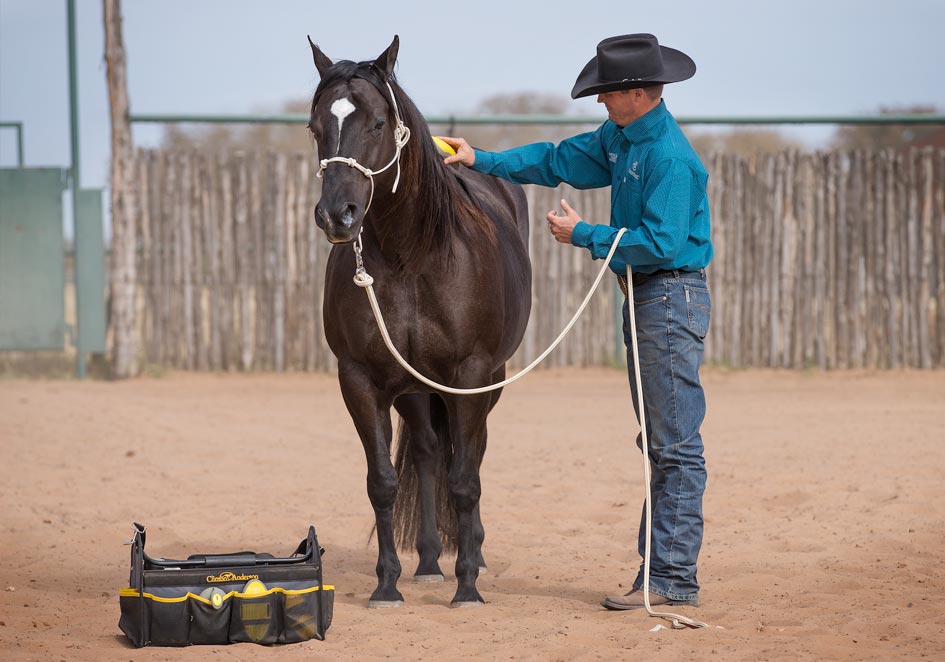
Take your horse to an open area and begin by brushing his topline.
Make the Right Thing Easy
Put the halter and lead rope on your horse and then take him, along with your grooming tools, out to the area where you plan to work with him. Stand at a 45-degree angle to his shoulder, an arm’s length away. Hold the lead rope in one hand and keep the horse’s head tipped slightly toward you. Standing in this position ensures that you stay safe in case the horse kicks out or strikes. As long as you’re at a 45-degree angle to his shoulder, he can’t reach you. And, as long as you keep his head tipped toward you, if he did take off, you could follow him wherever he went. As long as you have two eyes on you, you can outrun any horse. But the minute you let him turn his head and neck away from you, he gains the advantage and puts you in a dangerous situation.
Once you’re in position, begin to brush his topline—his withers, back, hindquarters and neck.
If the horse moves, drop the brush and put his feet to work. Do Lunging for Respect Stage Two, back him up for 100 feet, practice the Sending Exercise, etc. What you make the horse do isn’t important, what’s important is making sure you hustle his feet and ask him to do a lot of changes of direction.
The more you move his feet forwards, backwards, left and right, the quicker he’ll start to use the thinking side of his brain and relax. After making him hustle his feet for five minutes, stop him, pick up the brush and go back to grooming him. You’re making the right thing (standing still) easy and the wrong thing (moving) difficult. It’s kind of like you’re saying to the horse, “You don’t want to stand still? That’s fine by me, but if you’re going to move, it’s going to be on my terms.”
Anytime he gets fidgety and moves his feet, immediately put him to work. If you’re consistent, it won’t take the horse long to realize that standing still while you brush him is the best option. Oftentimes, the most effective correction you can make to a horse is hustling his feet. Horses are basically lazy creatures and would rather stand around with their legs cocked daydreaming about their next meal than moving their feet and If your working up a sweat. They’ll always choose the option with the least amount of work involved.
If your horse moves, immediately put his feet to work. It doesn’t matter what you make him do, just that you hustle his feet. You could do…
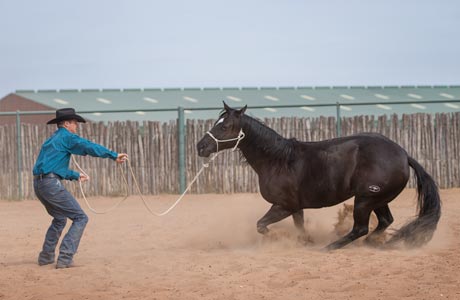
…Lunging for Respect Stage Two
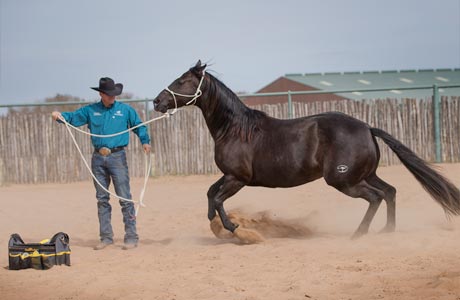
…the Sending Exercise
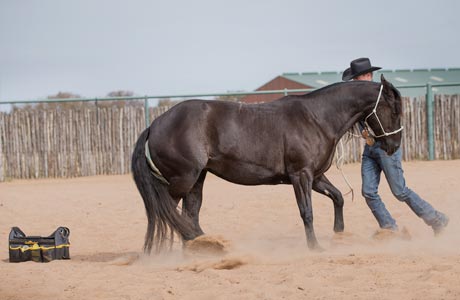
…back him up aggressively
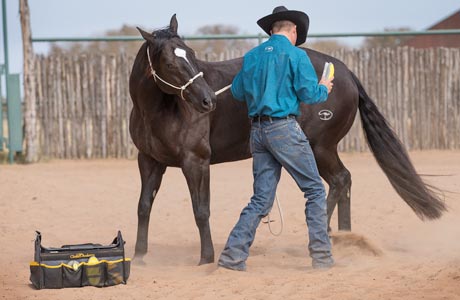
…or even yield his hindquarters with energy
When you’re able to brush the horse’s topline, then move down his side, under his belly and down his legs. Then switch sides and follow the same steps on the other side of his body.
When the horse remains standing still while you groom him in an open area, practice grooming him in your normal location. If he gets fidgety, apply the same “make the right thing easy, wrong thing difficult” technique. If he moves and you have him in the barn, take him out of the barn (even back him out if you can) to an area where you can work with him and hustle his feet for 10 minutes. Then bring him back to the barn and groom him as if nothing happened. If he fidgets again, repeat the same steps. Before long, he’ll realize that standing still in the grooming bay, cross ties or wherever you have him is far easier than having to hustle his feet. It’s similar to the approach I use to teach horses to load on the trailer—life is nothing but hard work outside the trailer and comfort and ease inside the trailer.
Addressing “Oh No!” Spots
If you have taken your horse through the Fundamentals and he’s fearful and reactive by nature, he could be fidgety at grooming time because he isn’t comfortable with his body being touched. This is where it’s important that you are very thorough with the desensitizing exercises with the lead rope and the stick and string where you get the horse used to your tools touching all over his body. When you first start working with them, all horses have what I like to call “Oh no! Don’t touch me there!” spots— areas on their body where they don’t like to be touched.
Eliminate Yourself
Before blaming your horse for not standing still while you groom him, make sure you’re not causing him to move by making him feel uncomfortable.
1) Use some feel while brushing him. When you brush the horse, be conscious of how hard you’re pressing. Each horse has a different sensitivity level, just like humans. If you barely touch the horse with the brush, it might feel ticklish to him and cause him to fidget. At the same time, you don’t want to brush him so hard that it makes him feel uncomfortable. Breeds like Thoroughbreds and Arabians tend to be thin skinned and require a lighter touch, while draft breeds, warmbloods and ponies tend to be thick skinned and enjoy a firmer touch. Remember, you want grooming to be a pleasant experience that your horse looks forward to.
2) Be aware of sensitive areas. Areas on the horse’s body that have few muscles and instead have bones near the surface, such as the face, legs and hips, are more sensitive and need to be groomed carefully and with a lighter touch. In these areas, it’s also important to use a soft brush that won’t make the horse feel uncomfortable.
3) Don’t be sneaky! The worst thing you can do when you’re working around your horse is to be sneaky in your actions. I’ve found over the years that the more you sneak around a horse and act like there’s a problem, the more the horse thinks there is a problem. Be very obvious in your actions when you’re working with your horse. Use a firm touch with a lot of feel when you’re rubbing and grooming him. Don’t act like you’re afraid to touch him and end up making him feel uncomfortable because you’re tickling him. The biggest mistake I see people make is acting cautious around the horse. Remember, the more you sneak around horses and act like there’s a problem, the more they think there is a problem.
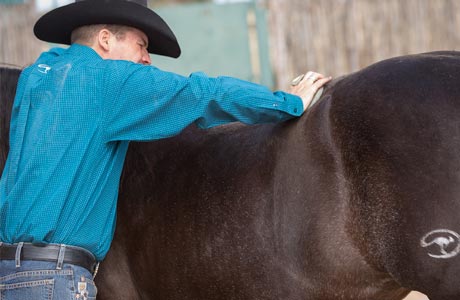
Be conscious of how hard you’re brushing the horse. You could be making your horse feel so uncomfortable that he’s trying to move away from you. I’m pressing way too hard for most horses’ comfort here.
After you’ve thoroughly desensitized your horse to the lead rope and stick and string, you’ll use the Approach and Retreat Method to desensitize him to your hands touching his body and then your grooming tools. By approaching him and then retreating when he stands still and shows a sign of relaxing, you’ll build his confidence. When a horse relaxes, he’ll do one of five things: he’ll lick his lips, lower his head, blink his eyes, cock a hind leg or take a big breath. When he stands still and shows one of these signs of relaxing, you’ll retreat and stop rubbing him in the sensitive area. Sometimes a horse won’t show you any of those signs, but as long as he stands still for 15 seconds, you can take away the pressure. If a horse stands still for 15 seconds, he’s telling you that he’s not interested in running. He may still be a little frightened, but he’s starting to use the thinking side of his brain and has chosen to stand still.
Start by desensitizing his body to your touch. Rub his topline (withers, back, hindquarters and neck) with the palm of your hand in a circular motion with a lot of feel. The topline is the least sensitive area on a horse’s body, which makes it the easiest and safest place to begin the desensitizing process. Horses are the most sensitive around their head, down their legs, near their flank and under their belly because they’re the most vulnerable in these areas. If anything happens to these body parts, their ability to flee is taken away from them, and all of their vital organs are located near their flank and under their belly. So most horses are defensive about these areas being touched and try to protect themselves as best as they can.
In the initial stages of desensitizing, you’ll stay away from the horse’s head, and just rub your hands up his neck to his ears. Your first priority is to desensitize his body to your touch. Once you’ve accomplished that, then you can worry about desensitizing his head.
As you rub the horse, don’t stay in any one place for a long period of time unless you find an “Oh no, don’t touch me there!” spot. You want to be constantly moving your hand along the horse’s topline, touching him in as many places as you can. Be careful not to pat the horse in a “tap, tap, tap” motion with your hand. You want to sooth him by rubbing him— patting makes him feel uncomfortable.
If you find an area he doesn’t like you touching, continue to rub that area of his body until he stands still and relaxes. As soon as he relaxes, retreat and move your hand to another area of his body that he’s comfortable with. Then come back to the spot again and rub him. Repeat that process, approaching and retreating, until the horse no longer cares if you rub the “Oh no, don’t touch me there!” spot.
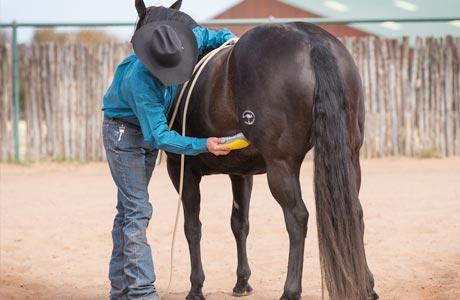
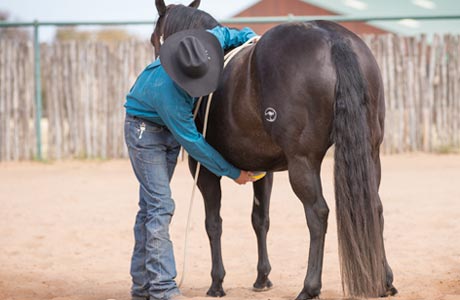
Be aware that horses are sensitive near their flanks and under their belly. You may have to spend extra time desensitizing these areas to your hand first and then the brush.
It’s important that you keep rubbing the horse in an area that he’s uncomfortable with until he stands still and relaxes. If you stop rubbing when he’s tense and/or moving his feet, you’ll teach him that when you touch him in that area, it’s OK for him to resist you. For example, if the horse is uncomfortable with you rubbing his neck and you stop touching him there as soon as he moves his feet or throws his head up, you’ll teach him that he doesn’t have to tolerate you touching his neck. You want the horse to realize that the only way he can escape your touch is by standing still and relaxing.
When the horse is comfortable with you rubbing his topline, start to rub his side. Using the Approach and Retreat Method, work your way down to the horse’s belly. Keep in mind horses are sensitive under their belly and near their flank. If the horse moves when you rub under his belly, be sure to keep rubbing until he stands still and relaxes. When he does stand still and relax, retreat from that spot and rub his topline. Then go back to rubbing his belly. Keep approaching and retreating from the area until the horse no longer cares if you touch him there. When you’ve desensitized one side of the horse’s body to your touch, switch sides and repeat the same steps.
Keep in mind that you may have to chip away at the issue a little each day if he is especially worried. For example, if the horse doesn’t like you touching his flank, you’ll first establish a starting point—an area where he is comfortable with you touching. In this example, that might be on his back. Once you’ve established a starting point, then you can use the Approach and Retreat Method to gradually work your hand down his side to his flank. But you don’t want to go straight from his back to his flank; you first have to build his confidence and trust. Maybe in the first session you’ll only make it halfway down the horse’s side before he becomes uncomfortable and resists you. That’s OK. As long as you’re making progress and increasing the horse’s comfort level, you’re doing your job. It may be the third or fourth session before you can rub his flank while he stands still and relaxes. That’s perfectly fine.
When you can rub your hands all over the horse’s body, follow the same steps using a soft brush.
Hot tip:
If your horse suddenly seems sensitive for no reason, look for a possible injury. The beginnings of a skin ailment or a bruise from a kick, for example, may make a horse fidgety or nip if the sensitive area is brushed.
Counter Conditioning
If your horse’s problem isn’t that he moves, but that he tries to nip or kick you, you can also try using a form of counter conditioning to correct his behavior. Some horses, especially young ones, get nippy when you’re grooming them because they’re trying to groom you back. In a herd, horses will stand nose to tail and use their teeth and lips to groom each other. Sometimes, young horses think they’re returning the favor by “grooming” you back. It may be cute when the horse is young, but it can quickly turn dangerous, and at no time do you want any horse of any age thinking it’s OK to use his teeth on you.
So, if you know your horse has a tendency to try to nip you when you’re brushing him, without even looking at him, flap your elbow out to the side so that he runs into it with his nose and feels uncomfortable. You have to time it just right so that at the same time he leans forward to nip you, he runs into your elbow. The secret is not to look at him or act like you’re moving your arm on purpose. It’s like your elbow just developed a nervous twitch. If you look at the horse, it’s like you’re acknowledging that you’re the one making him feel uncomfortable. You want the horse to think that he’s doing it to himself. Every time he leans in to nip you, he runs into your elbow. Horses always learn faster when they teach themselves the lesson. It won’t be long before your horse is like, “I really need to keep my lips to myself because I seem to be running into his elbow.”
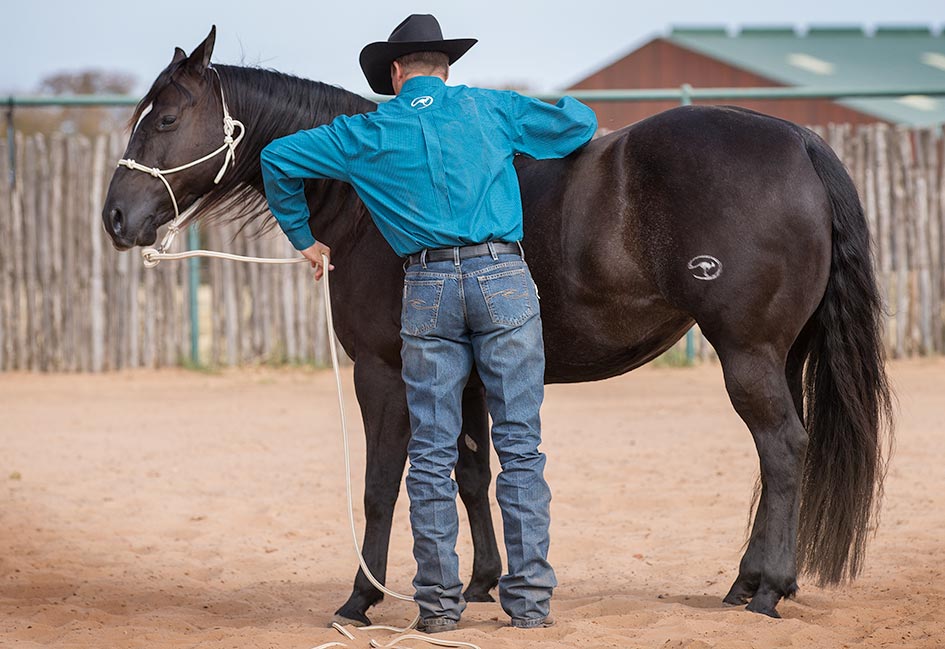
If your horse tries to nip you, flap your elbow toward his nose at the exact same time he reaches around to bite you.
Some horses will get defensive and kick out when you groom them. This behavior is especially common when you’re brushing under the horse’s belly or near his flank. If you’ve used the Approach and Retreat Method to desensitize the horse to your hands and grooming tools and he’s still kicking out at you, you can use counter conditioning to fix the problem. Every time the horse picks his hind foot up and kicks out, knee him in the belly as hard as you can. Your timing has to be spot on here—as soon as you see him pick his foot up, immediately thump him hard in the belly. You want him to think that he’s making himself feel uncomfortable.
Now, someone will read what I just said about kneeing the horse in the belly and think “That’s cruel! How could you do that to your horse?” It’s funny to me what people will get their knickers in a knot over. If they saw a horse kick another horse in the pasture, they’d think nothing of it, but they see a human knee a horse in the belly and they want to call PETA. You can’t possibly make your horse feel as uncomfortable as another 1,000-pound horse kicking him could.
But let’s get something straight, if your horse kicks you, he’s going to do a whole lot of damage that could put you in the hospital or much worse. Disrespectful behavior like kicking is nothing to mess around with. But again, if you just do the Fundamentals with your horse and earn his respect and prove to him that you’re a trustworthy leader he doesn’t need to fear, 95 percent of any sort of behavioral problem will fix itself.
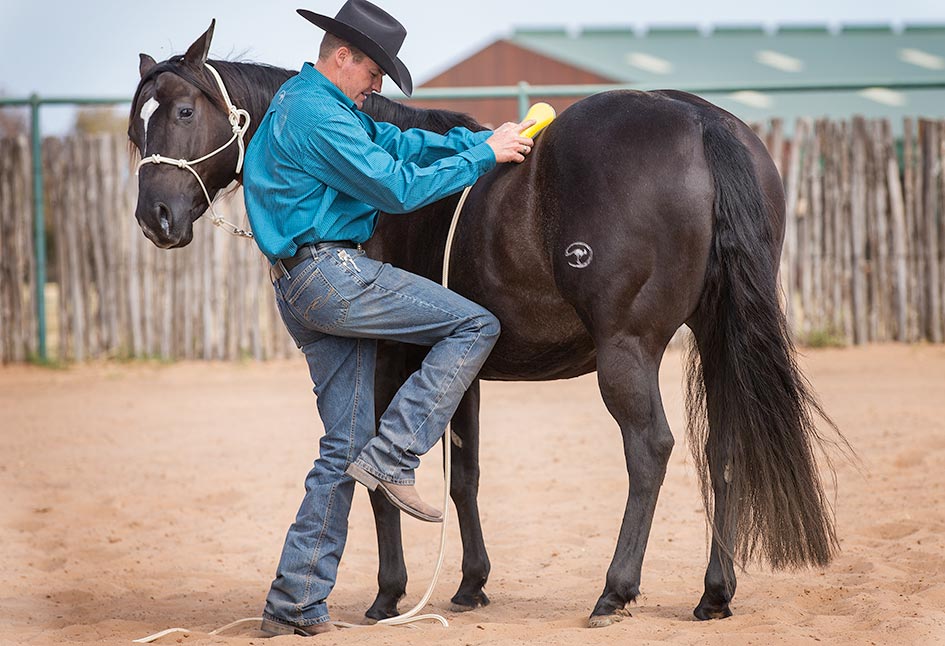
Every time your horse picks his foot up to kick you, knee him in the belly. Then move his feet with a lot of hustle.
Did you know?
Clinton’s performance horses and Diez are groomed for at least 20 minutes daily to bring a natural shine to their lustrous coats. Each side of the horses’ bodies are curried for 10 minutes. Using a currycomb will really bring out a horse’s shine and help to keep his coat healthy.
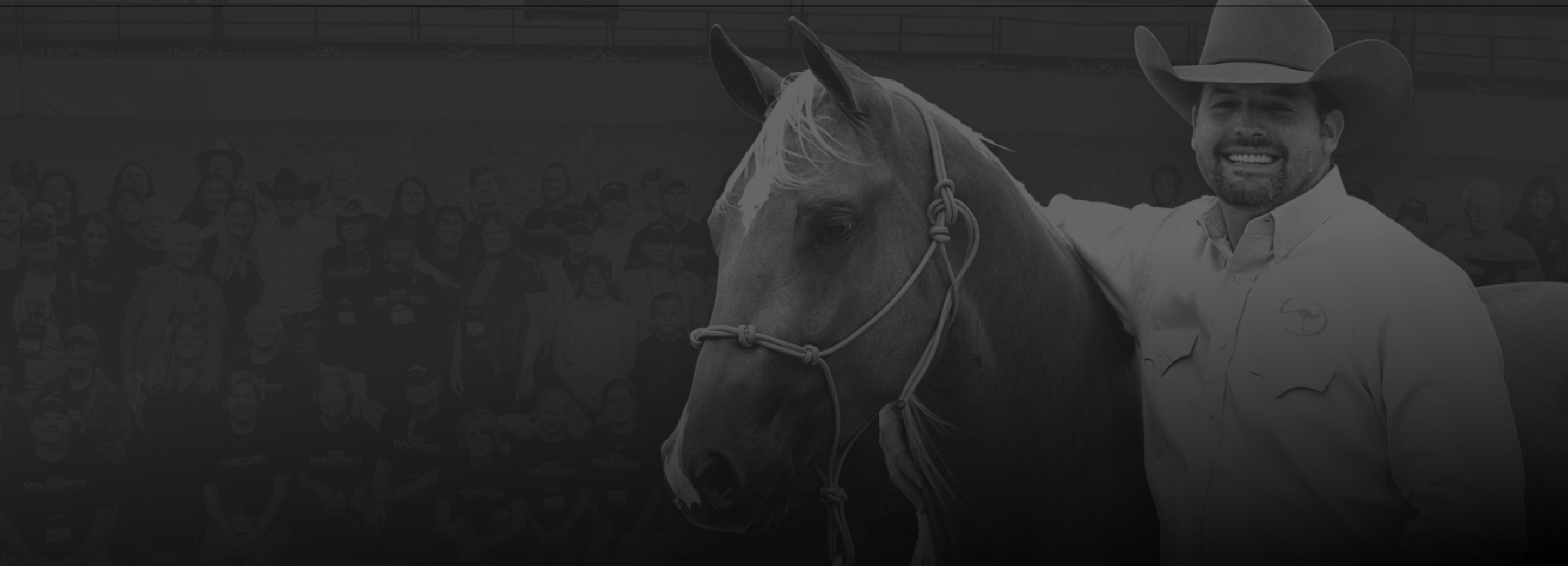
Want To Learn More? SIGN UP FOR OUR LOYALTY PROGRAM
Master your horsemanship training through Clinton’s step-by-step method videos by joining the No Worries Club today. Becoming a club member ensures you get VIP pricing on all of Clinton’s must-have training tools and resources. Plus, you’ll enjoy all the phenomenal benefits that come with club membership!



